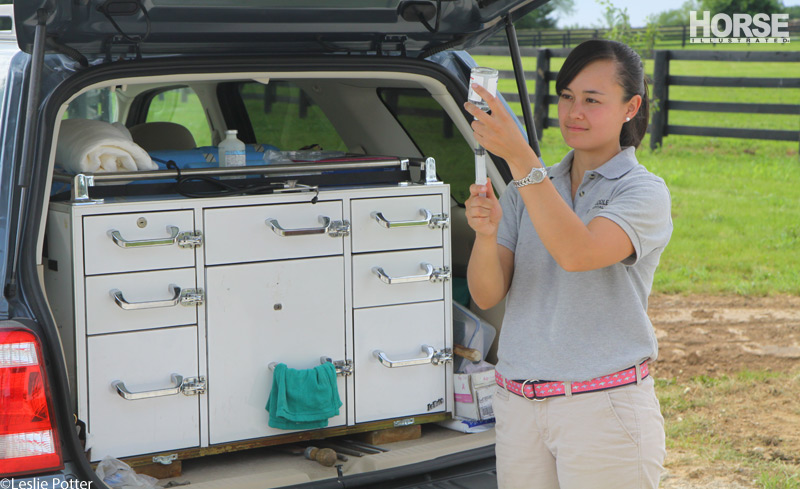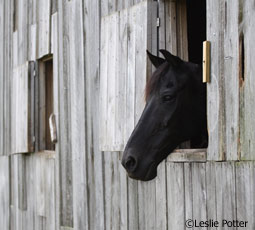
Equine influenza is a respiratory virus that is very common in horses. Highly contagious, this disease can be avoided with a proper vaccination program.
Equine influenza is spread by aerosol; when an infected horse coughs or snorts, the infectious viral particles enter the immediate air and are subsequently inhaled by other horses. When exposed to the influenza virus, a horse will incubate the viral particles for one to three days. During this time, the virus replicates mostly in the upper respiratory tract. Enzymes produced by the virus attack the cells that line the trachea and bronchi, resulting in inflammation and damage to the cells that line these airways.
Once infected, the horse will begin to show clinical signs three to five days after exposure to the virus. Typically, a horse with influenza will develop a fever that may be as high as 105 degrees Fahrenheit, have serous nasal discharge, depression, inappetance, and a deep, dry cough. Lymph nodes around the throat may become enlarged, and the horse may also be reluctant to move because of muscle soreness.
In uncomplicated cases when a horse’s immune system can adequately fight off infection, these clinical signs resolve within two to ten days. However, the horse will continue to shed live virus and therefore be infectious for up to a week after the resolution of clinical signs.
Treatment of equine influenza is supportive care. Ensuring the horse is adequately hydrated and resting quietly in an environment free of stress are the most important treatment aspects. Pain medication such as flunixin meglumine (Banamine) may be given to help offset muscle soreness and respiratory pain. Banamine will also help decrease fever, making the horse feel better and therefore encourage eating and drinking. Offering soft moist feed such as bran mash can also encourage the horse to eat. Sometimes, a course of prophylactic antibiotics may be given. The greatest risk of influenza is the complication of a secondary bacterial infection that can cause pneumonia.
After clinical signs have passed, it is important to allow the horse plenty of recovery time before bringing him slowly back to work due to the damage the virus has on the respiratory system. A few weeks off may be adequate in mild cases, while severe cases may require months of recuperation before return to work.
Not all horses are at equal risk for influenza infection. Young horses between the ages of one and five years are at a higher risk because of their immature immune system. Immunity against influenza infection increases with age, but older horses that are under increased stress from travel, showing, or intense physical activity are also at higher risk of infection. Frequent exposure to large numbers of horses, such as at large shows, racetracks, large trail rides, and traveling, increases the exposure rate to the virus and therefore increases the risk of infection as well.
Luckily, there are certain management practices you can implement to drastically decrease your horse’s chances of contracting equine influenza. Vaccinating your horse against influenza is the most important method of preventing this disease. All horses should be vaccinated at least yearly against influenza, unless they are never in contact with other horses.
One challenge with properly vaccinating against influenza is the ability of the virus to undergo antigenic drift. This natural process occurs when various subtypes of the virus are prevalent for a few years within the horse population and then are replaced by another subtype. Once a vaccine is manufactured, it generally protects against one subtype better than another, leaving the horse susceptible to infection by that other subtype. For this reason, vaccine manufacturers have been advised to keep up-to-date on the most current influenza subtype and you should never administer an influenza vaccine that is past its expiration date.

Vaccination strategies for equine influenza are not the same for all horses and must be based on each individual horse’s age, environment, and exposure to others. Adult horses that travel regularly to shows or have other regular exposure to horses that have traveled (for example, a large boarding stable), should be vaccinated every six months. Although in the past, at-risk adult horses have sometimes been vaccinated as frequently as every three months, current vaccines stimulate immunity for at least six months, making these extra vaccinations unnecessary.
Adult horses that do not travel or have regular contact with horses outside their immediate area can be vaccinated yearly. Pregnant mares should be vaccinated four to six weeks before foaling, so that some immunity is passed to the foal. Foals should begin their influenza vaccines at six months of age. This is important since influenza in foals can be highly virulent and lead to complications and death within days.
One other important factor when preventing against influenza is proper quarantine procedures. If you are introducing a new horse into the stable, quarantine this animal for fourteen days. This allows for enough time for the virus to incubate, show clinical signs, and then become non-infective before allowing this horse contact with others. Additionally, proper hygiene is important for prevention. At shows, try not to share water buckets or grooming equipment with strange horses. At home, keep fresh air circulating through the barn and reduce pollutants such as dust from hay and straw in order to support a healthy respiratory tract. Regular stall cleaning will prevent the build up of ammonia fumes that can be damaging to the respiratory tract, leaving the horse more susceptible to infection.
Learning the signs of infection and understanding proper vaccine strategies are all important when understanding equine influenza. This knowledge can help you protect your horse against infection.






Good to remember.
I hate the thought of giving that many vaccines…
good to know
I love Horse Channel!